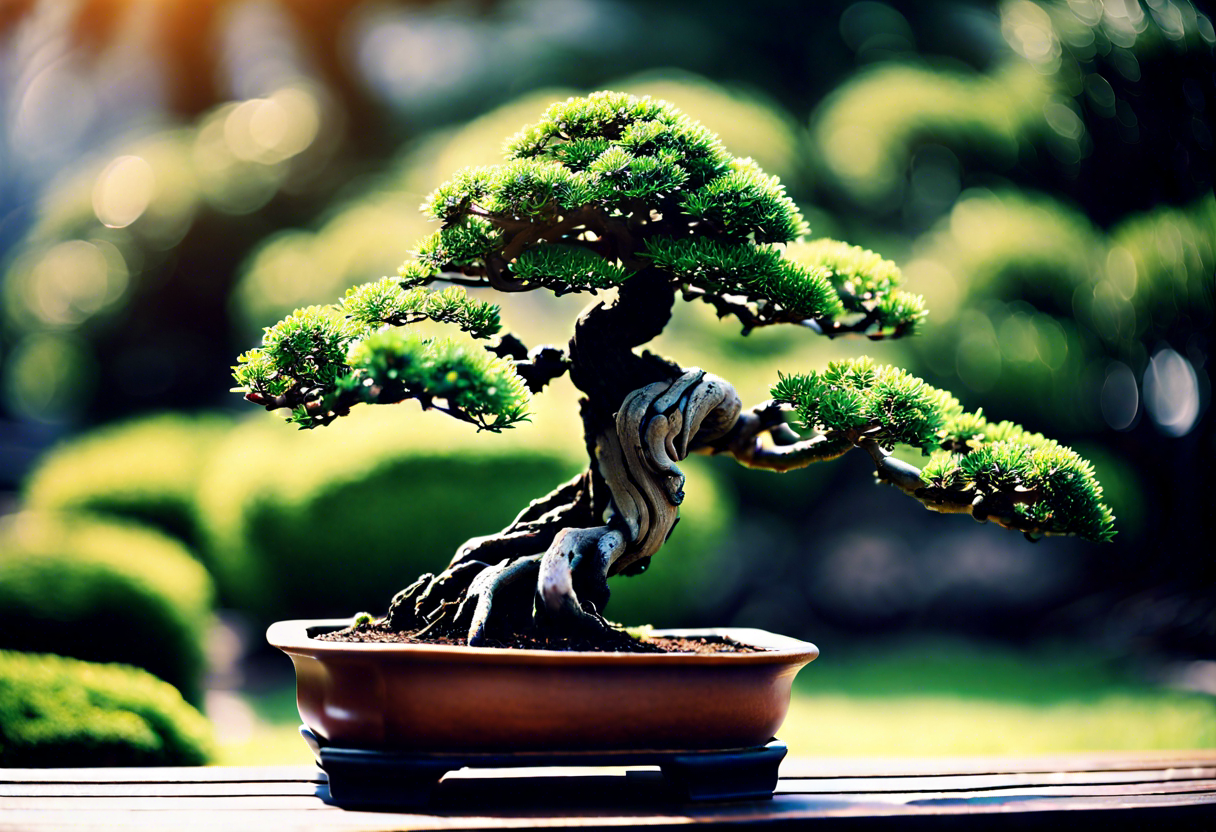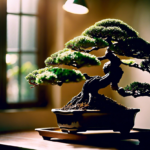Explanation of the Bonsai Tree and Its Cultural Significance
A bonsai tree is a miniature tree grown in a small container or pot through careful pruning, wiring, and shaping to create a realistic representation of a full-grown tree in nature. The art of cultivating bonsai originated in China over a thousand years ago and later gained popularity in Japan, where it was further refined into a highly respected form of art and culture.
Bonsai trees hold significant cultural symbolism in various Asian societies, representing harmony, balance, and peace. In Japanese culture, the cultivation of bonsai is a meditative practice that encourages patience, mindfulness, and a deep connection with nature. The careful attention to detail required in nurturing a bonsai tree reflects the values of discipline, perseverance, and respect for the natural world.
Throughout history, bonsai trees have been associated with nobility, tranquility, and the beauty of the changing seasons. The intricate art of bonsai cultivation has been passed down through generations, with each tree telling a unique story and carrying with it the essence of the grower’s creativity and dedication.
Today, bonsai trees are admired worldwide for their artistic beauty and profound cultural significance. Enthusiasts around the globe appreciate the elegance and serenity that bonsai trees bring to indoor and outdoor spaces, making them a popular choice for home décor, gifts, and spiritual practice.
For more information on bonsai trees and their cultural heritage, visit Bonsai Empire website for expert insights and resources.
Different Types of Bonsai Trees and Their Characteristics
Bonsai trees are miniature replicas of full-sized trees that are carefully cultivated to maintain their small size. There are several types of bonsai trees, each with its unique characteristics and requirements. Understanding the different types of bonsai trees can help enthusiasts choose the right one for their preferences and skill level.
Types of Bonsai Trees:
-
Deciduous Bonsai Trees: Deciduous bonsai trees, such as maple and beech, shed their leaves seasonally, offering a variety of colors and textures throughout the year. These trees require regular pruning and maintenance to flourish.
-
Evergreen Bonsai Trees: Evergreen bonsai trees, like pine and juniper, retain their foliage year-round, providing a consistent green canopy. They are well-suited for beginners due to their hardiness and adaptability.
-
Flowering Bonsai Trees: Flowering bonsai trees, including azalea and cherry blossom, produce beautiful blooms that add an extra element of elegance to the miniature tree. These trees require specific care to promote flowering.
-
Tropical Bonsai Trees: Tropical bonsai trees, such as ficus and jade, thrive in warm and humid environments, making them ideal for indoor cultivation. They often exhibit aerial roots and unique trunk formations.
-
Fruit-Bearing Bonsai Trees: Fruit-bearing bonsai trees, like citrus and pomegranate, offer both aesthetic appeal and the possibility of harvesting miniature fruits. These trees require diligent care to ensure fruit production.
Characteristics of Bonsai Trees:
-
Size: Bonsai trees range in size from just a few inches to several feet tall, with each size category having specific designations such as mame (under 6"), shohin (6"-8"), and chuhin (8"-16").
-
Style: Bonsai trees can be styled in various forms, including formal upright, informal upright, slanting, cascade, and semi-cascade, each representing a different aesthetic and growing direction.
-
Age: The age of a bonsai tree is determined by factors such as trunk thickness, root spread, and overall appearance, with older trees often exhibiting more refined characteristics.
-
Pottery: Bonsai trees are typically planted in ceramic pots that complement their size and style, with different shapes, colors, and textures available to enhance the overall presentation.
By exploring the different types of bonsai trees and their unique characteristics, enthusiasts can appreciate the diversity and artistry of this ancient horticultural practice. Whether cultivating a flowering bonsai tree for its aesthetic beauty or a tropical bonsai tree for its lush foliage, each type offers a rewarding and fulfilling experience for bonsai enthusiasts.
For more in-depth information on bonsai tree types and characteristics, you can visit Bonsai Empire for a comprehensive guide to bonsai cultivation.
Essential Tools and Techniques for Bonsai Tree Care
When it comes to caring for your bonsai tree, having the right tools and employing proper techniques is essential for its health and overall appearance. Bonsai trees require specific care to thrive and flourish, making it crucial to understand the tools and techniques needed to maintain these miniature masterpieces.
Tools for Bonsai Tree Care
- Pruning Shears: These are essential for trimming back new growth, maintaining the shape of the tree, and removing dead or unhealthy branches.
- Branch Cutters: Used for thicker branches that pruning shears cannot handle, branch cutters ensure clean cuts to promote healing and prevent damage.
- Concave Cutters: Ideal for removing branches without leaving unsightly scars, concave cutters help create natural-looking wounds that heal seamlessly.
- Wire Cutters: Essential for shaping your bonsai tree by applying and removing wire, wire cutters ensure precision and prevent damage to the branches.
- Root Rakes: Used for gently combing through the roots during repotting, root rakes help prevent root circling and promote a healthy root system.
- Bamboo Chopsticks or Tweezers: Perfect for delicate work such as removing debris, moss, or adjusting small wires without causing damage.
Techniques for Bonsai Tree Care
- Pruning: Regular pruning helps maintain the shape and size of the tree, encourages new growth, and improves overall health by allowing sunlight and air circulation.
- Wiring: Strategic wiring is essential for shaping your bonsai tree, guiding branches into the desired position, and creating the desired aesthetic appeal.
- Repotting: Repotting your bonsai tree every 1-3 years (depending on the species) helps refresh the soil, prevent root bound issues, and promote healthy growth.
- Watering: Proper watering is crucial for bonsai trees, as overwatering or underwatering can lead to root rot or dehydration. Finding the right balance is key to the tree’s health.
- Fertilizing: Regular fertilization throughout the growing season ensures that your bonsai tree receives essential nutrients for healthy growth and vibrant foliage.
By utilizing the right tools and mastering essential techniques for bonsai tree care, you can create a flourishing and visually captivating miniature tree that brings beauty and tranquility to your home or garden. Remember, each bonsai tree is a unique living work of art that requires dedication, patience, and skill to nurture and shape over time.
For more in-depth guidance on bonsai tree care tools and techniques, you can visit Bonsai Empire for comprehensive resources and expert advice on cultivating and maintaining your bonsai masterpiece.
The Art of Bonsai Tree Shaping and Pruning
Bonsai tree shaping and pruning are fundamental aspects of bonsai cultivation that require careful attention and skill. Shaping and pruning help maintain the miniature size and aesthetic appeal of bonsai trees, reflecting the essence of nature in a confined space. By understanding the art of shaping and pruning, enthusiasts can create stunning bonsai trees that showcase their unique styles and visions.
Shaping a bonsai tree involves guiding its growth to achieve a desired form or silhouette. This process requires patience and an eye for detail, as each cut influences the tree’s overall appearance. Techniques such as wiring, pruning, and clamping are commonly used to shape bonsai trees. Wiring allows the branches to be trained into specific positions, while pruning helps control the tree’s size and shape. Clamping involves gently bending branches to create movement and interest in the tree’s design.
Pruning is another essential practice in bonsai tree care that focuses on maintaining the tree’s health and aesthetics. Regular pruning helps remove dead or overgrown branches, promotes new growth, and enhances the tree’s overall structure. There are two main types of pruning: maintenance pruning, which is done regularly to upkeep the tree’s appearance, and structural pruning, which involves more significant cuts to refine the tree’s shape over time.
When shaping and pruning a bonsai tree, it is crucial to consider the tree’s species, growth patterns, and overall design goals. Different species of bonsai trees have unique characteristics that influence how they should be shaped and pruned. For example, coniferous bonsai trees require different pruning techniques than deciduous trees due to their growth patterns and foliage density. Understanding these differences is essential for maintaining the health and vitality of the bonsai tree.
To master the art of bonsai tree shaping and pruning, enthusiasts should invest in high-quality tools such as concave cutters, knob cutters, and branch cutters. These tools are specifically designed for bonsai care and help achieve precise cuts without damaging the tree. Proper technique and knowledge of bonsai aesthetics are also crucial for successful shaping and pruning. By studying traditional bonsai styles and techniques, enthusiasts can develop their artistic sensibilities and create harmonious bonsai compositions.
Shaping and pruning are essential practices in bonsai tree care that require skill, patience, and dedication. By mastering the art of shaping and pruning, bonsai enthusiasts can create beautiful miniature trees that capture the beauty and tranquility of nature in a small-scale setting. With the right tools, techniques, and knowledge, anyone can enjoy the meditative art of bonsai tree shaping and pruning.
Tips for Choosing the Right Bonsai Tree for Your Home
When it comes to choosing the perfect bonsai tree for your home, there are several factors to consider to ensure its health and longevity. Bonsai trees are not only beautiful ornamental plants but also living artworks that require proper care and attention. Here are some tips to help you select the right bonsai tree for your living space:
1. Consider the Size: Bonsai trees come in various sizes, ranging from tiny miniatures to larger specimens. Before purchasing a bonsai tree, think about where you intend to place it in your home. Smaller bonsai trees are ideal for desktops or small shelves, while larger ones can become a statement piece in a room.
2. Assess the Lighting Conditions: Different species of bonsai trees have varying light requirements. Some trees thrive in bright, indirect light, while others prefer more shade. Before choosing a bonsai tree, assess the lighting conditions of the intended location to ensure it matches the tree’s needs.
3. Research Tree Species: Each species of bonsai tree has unique care requirements. Some species are more forgiving for beginners, such as the Ficus or Chinese Elm, while others like the Juniper or Pine require more advanced care techniques. Research different tree species to find one that aligns with your skill level and commitment.
4. Consider Maintenance: Bonsai trees require regular maintenance, including watering, fertilizing, and pruning. Before selecting a bonsai tree, consider the time and effort you are willing to dedicate to its care. Some species are more high-maintenance and may require daily attention, while others are more forgiving.
5. Seek Guidance: If you are new to bonsai cultivation, seek guidance from experienced growers or bonsai professionals. They can provide valuable insights into selecting the right tree species, as well as offer tips on care and maintenance.
By considering these tips when choosing a bonsai tree for your home, you can ensure that you select a tree that not only fits your living space but also thrives under your care. Remember that bonsai cultivation is a rewarding journey that requires patience, dedication, and a deep respect for these living works of art.
For more information and inspiration on choosing the right bonsai tree for your home, check out Bonsai Empire, a comprehensive resource for bonsai enthusiasts of all levels.
Conclusion
In understanding the art of bonsai, it becomes evident that this ancient practice encompasses not only horticulture but a deep-rooted cultural connection and artistic expression. Various types of bonsai trees, each with unique characteristics, allow enthusiasts to delve into a world of diversity and beauty. The importance of using the right tools and techniques cannot be overstated, as they play a crucial role in ensuring the health and vitality of these miniature trees. Moreover, the careful art of shaping and pruning a bonsai tree requires patience, skill, and a deep appreciation for nature’s beauty.
When selecting a bonsai tree for your home, it is essential to consider factors such as the tree’s size, shape, and care requirements. Whether you opt for a traditional Chinese Elm or a vibrant Azalea bonsai, each tree brings its own charm and personality to your living space. By following expert tips and guidelines, you can embark on a rewarding journey of bonsai tree care and cultivation.
The bonsai tree is not merely a plant but a living art form that reflects the delicate balance between nature and human creativity. Its rich cultural significance, coupled with the myriad of bonsai tree varieties available, offers enthusiasts a limitless canvas to explore their passion for this ancient tradition. With the right tools, techniques, and care, anyone can experience the joy of shaping and nurturing a bonsai tree, bringing a touch of tranquility and beauty into their homes. So, whether you are a seasoned bonsai aficionado or a newcomer to this captivating world, let the bonsai tree inspire you to connect with nature in a truly unique and artistic way.


